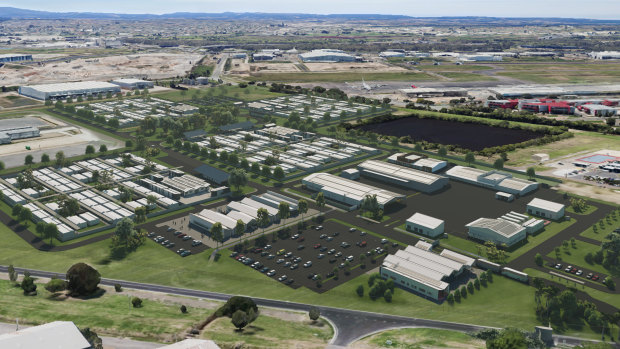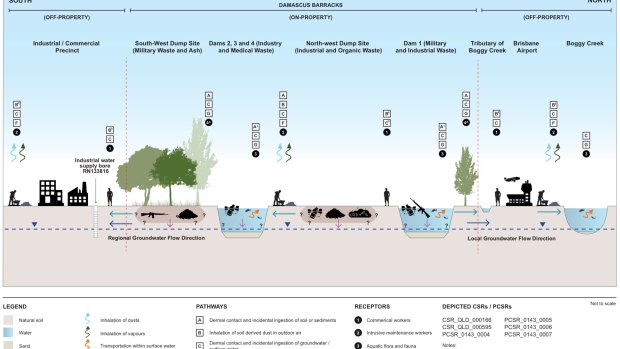This was published 3 years ago
Defence buries ‘contamination’ at Brisbane quarantine site behind secret web page
By Sean Parnell
The Department of Defence continues to declare on its website there is “no known contamination” at a Brisbane barracks despite obtaining evidence of chemical, lead, asbestos and military waste issues.
Documents obtained under Freedom of Information laws reveal the department was aware of the contamination before Damascus Barracks was chosen as the site for a new 500-bed quarantine facility.
Consultants called in by the department made their risk assessment on the basis that the barracks at Pinkenba would continue to have an industrial, not semi-residential, use - and still declared some areas “medium risk” to human health.

An artist’s impression of the proposed Centre for National Resilience at Pinkenba near Brisbane Airport.
Recent flooding has delayed construction of the facility, and the plans were changed early in the process to move the accommodation units away from an old dump site thought to be problematic.
The Defence website has a section on its Regional Contamination Investigation Program, listing dozens of sites under scrutiny to “define and reduce contamination risks to human health and the environment”.
For Damascus Barracks, the website gives April 2016 as the date of last review, with a summary statement that “there is no known contamination at the property”.
The department has previously declined to provide updated information to the media.
However, an unpublished page obtained under FOI laws, bearing an identical format and marked as a “draft document pending consultation”, gives the date of last review as February 2021 - four months before the site was proposed for the quarantine facility.
It then gives a summary of the “known contamination”.
“Waste disposal areas and former tank sites have been assessed as a medium risk to human health and the environment. The dams have been assessed as low risk. Defence seeks to verify and minimise risks caused by contamination during the planning and conduct of all base activities. Ongoing management precautions such as routine monitoring will continue where necessary.”
Other documents refer to the “dumping of equipment, munitions and chemicals” into dams at the barracks, and the presence of PFAS deserving of further investigation.
Groundwater monitoring wells were either missing or destroyed, and the barracks has not been added to the list of Defence sites with PFAS.
While the consultants recommended containment, and further monitoring and study, their findings were based largely on the site continuing to have an industrial use and the soil and dams remaining undisturbed.
There is no suggestion the contractors engaged to build the facility would not have followed protocols for working on potentially contaminated sites.
AECOM, which conducted some of the assessments obtained under FOI, was also engaged to conduct a subsequent feasibility study for the facility. It warned the likely contamination added “significant volume of program and cost risk” and recommended “minimal ground works”.

An image, depicting contamination at Damascus Barracks, provided by consultants AECOM to the Department of Defence.
The facility, known as the Centre for National Resilience Brisbane, is due to be handed over to the state government to manage from May. A similar state-run facility at Wellcamp airport in Toowoomba exists, however there have been questions over its long-term use.
One corner of the barracks was previously annexed to allow construction of an immigration detection centre.